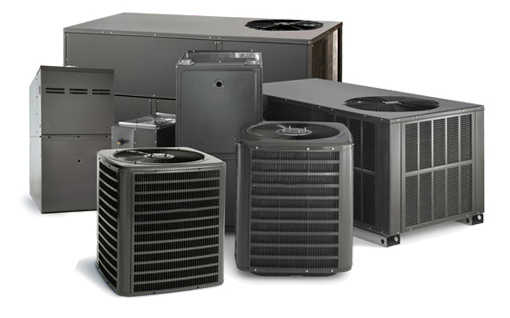"OK.. So, why are there so many of these efficiency ratings out there?"
 As you you may or may not know, there are many different types of cooling systems, heating systems, furnaces and other pieces of HVAC equipment out there that all work in various ways and use various methods to heat or cool something. As such, there are also different forms of measuring energy efficiency from one equipment type to the next.
As you you may or may not know, there are many different types of cooling systems, heating systems, furnaces and other pieces of HVAC equipment out there that all work in various ways and use various methods to heat or cool something. As such, there are also different forms of measuring energy efficiency from one equipment type to the next.
The DOE (Department Of Energy) is responsible for mandating and enforcing which efficiency standards apply to which pieces of HVAC equipment and currently supports testing and verification of efficiency ratings for HVAC products through the Energy Star program, which works in close collaboration with the EPA (Environmental Protection Agency) to deliver these energy efficiency statistics accurately to consumers.
Some efficiency ratings are required to be labeled on specific pieces of heating and cooling equipment by the Federal Trade Commission, while others are not, so it's important to focus on what is not only required, but what isn't required to be labeled as well, as you'll often find that what's required to be labeled can be very misleading if we don't fully understand what the label means.
Often energy efficiency can be mistaken for cost effective operation, but the truth is these are often two complete different concepts.
Take a look at the two Energy Star AFUE (Annual Fuel Utilization Efficiency) labels below from two different types of commonly used forced air furnaces, which are comparing an all electric furnace's AFUE efficiency rating to a natural gas furnace's AFUE efficiency rating, and answer the quiz question below to the best of your ability based off what you know now.
Don't worry if your not familiar with what the efficiency rating AFUE means just yet, we'll get to that in a bit. This is an exercise meant to demonstrate how efficiency labels can be misleading if we don't fully understand their meaning.
Electric Furnace vs Gas Furnace AFUE Ratings
| Electric Furnace | Gas Furnace |
|---|---|

|

|
|
The electric furnace has an AFUE rating of 100%, and the natural gas furnace an AFUE rating of 92.1%.
|
|
Quiz: If both types of forced air furnace's (electric / natural gas) produce the same amount of heat in a home, and both furnaces are operated for the same length of time during a winter season, which furnace is the most cost effective choice to operate in order to heat the home?
Upon first glance we can easily see the that the electric furnace's AFUE energy efficiency rating is higher than the natural gas furnace's AFUE rating.
Based on this fact alone, it's easy to assume that since the electric furnace's AFUE energy efficiency rating is highest, that it is also the most cost effective to operate in order to heat up the home.
But, if you thought that just because the electric furnace has the higher AFUE rating that it would also cost the least amount of of money to operate in order to heat up the home, you would actually be wrong and had just made a very costly mistake!
The electric furnace may have an AFUE of 100%, but this simply means that the electric furnace is capable of transferring 100% of the heat that it has generated from electricity into the air of the home it's attempting to heat up.
That is to say, the electric furnace has a higher fuel efficiency rating (which is what AFUE represents).
But, if your not careful when interpreting this efficiency label, you may fail to realize that we're actually comparing the fuel efficiency ratings of two complete different fuels even though the same type of efficiency rating (AFUE) is listed on both furnaces!
And, since the price of electricity (currently) costs more to use as a fuel to create the same amount of heat that the natural gas furnace creates by burning natural gas, it actually costs much more to operate the electric furnace's heating function vs the natural gas furnace's heating function in order to heat up a home - Even if the natural gas furnace is only transferring 92.1% of it's heat into the home, and even when both furnaces are ran for the exact same time.
So, even though the electric furnace is more efficient, it still costs more to operate. This is precisely why it's important to understand what each efficiency rating means, and exactly how each efficiency rating applies to the piece of heating or cooling equipment it's labeled on, as you'll often find the same efficiency ratings listed on different types of equipment.
Remember: The engineers and researchers who create these efficiency labels only concern themselves with how energy efficient an appliance is - Efficiency ratings have nothing to do with the cost of the resources an appliance makes use of.
In other words: Without understanding what an efficiency label means, you're probably taking a big risk if you're relying on it from a cost perspective.
So, it's important to understand exactly what each efficiency rating represents as well as how your equipment operates so you can focus on the ratings that are most relevant to the type of HVAC equipment your specifically interested in, while ignoring the rest that simply aren't relevant from a cost perspective.
It's these important, and often over-looked aspects of efficiency labels that we're going to explore today by outlining exactly what the labels mean, how they are listed, which ones aren't listed, and what other factors are involved with HVAC efficiency that you should also be concerned with when comparing the many types of HVAC systems available today.

